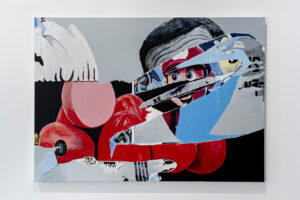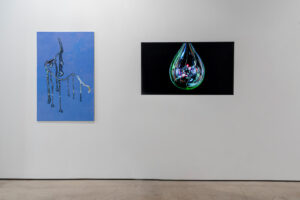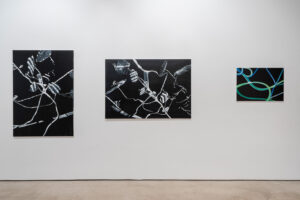Photos by Maru Serrano
Martin Ebner
Klaus Weber
LEVITY AND GRAVITY
Rosenblut and Friedmann Gallery
Bárbara de Braganza 9, Madrid
Opening reception
14.Sept 2024, 12:00h
Exhibition open until
Sat 02.Nov 2024

Martin Ebner, YOUNG DRAGON
acrylic paint on canvas
40 x 30 cm, 2024

Martin Ebner, DROP CAR / ONE LESS
single channel HD video, audio, 10 min, 2021
The German philosopher Walter Benjamin believed that “to lose one’s way in a city, as one loses one’s way in a forest, requires some schooling”. Those who get lost intentionally, look at their surroundings with different eyes, and only then can unravel the book of history that, according to Benjamin, is written in the objects of the city. For him, every epoch needs a walker who, like a detective or an ethnographer, must abandon a gaze that has been tamed by routine in order to decipher the meaning hidden in material things. The artists Martin Ebner and Klaus Weber belong to this lineage of walkers. Wandering attentively, they penetrate the meaning of things and transform their findings into a multiplicity of works that lead us to question our preconceived ideas of reality.
Martin Ebner (Austria, 1965) walks the streets of each city he visits, observing carefully, looking for objects that represent the inner psychology of those spaces. As if he were a natural scientist, when he finds these objects, he photographs them and stores them in a visual diary that he has kept for more than thirty years. Several paintings in this exhibition are reinterpretations of images taken from this archive in which he preserves his memory, which is also the memory of the cities.
Ebner not only collects images but also toys, like Benjamin. Three works in this exhibition are based on toys that have ended up in his hands. Ebner modifies the colours, focus, and size to highlight the psychological features they conceal. Like the black bottomless eyes of the panther in ‘Tokyo Panther’, in which Ebner sees the same sad aura he perceived in the inhabitants of that city. For him, as for Benjamin, children’s toys are deeply related to the desires and fears of adults. However, while Benjamin sought to construct a social history out of the toys, Ebner, in his paintings, extracts their inner psyche. Therefore, it is no coincidence that emotions may be perceived through his paintings of umbraculums (those roofs of branches that provide shade without cutting off the air), which were based on photographs taken in his mother’s garden. These works, despite being minimalist and of cool tones, express human emotions such as serenity or sadness, even transforming the rigidity of the branches into the graceful movements of a dancer. Using conceptual procedures, Impressionist and Expressionist techniques, and the humor of postmodern art, Ebner reinvents memory.
Today, a walker’s utopia is a city without cars. In the video ‘One Less’, Ebner pays homage to the pedestrians of the world by removing a car from their path. It is a subtle fantasy that he filmed in Japan, where he spent some time, walking the streets and noticing the devotion given to cars. An increasingly widespread devotion in the world, as if the car was a technological prosthesis of the body, the space of a futuristic utopia, “the closest thing to getting inside a smartphone”. In this work, the technological arrogance of the automobile is stripped of its protective aura, becoming a small child’s toy among the chopsticks of a playful god. Combining Japanese minimalism with a visual fantasy reminiscent of filmmaker Georges Melies, Ebner creates a work of mystical humor.
Alan Meller
from: Levity and Gravity, 2024











